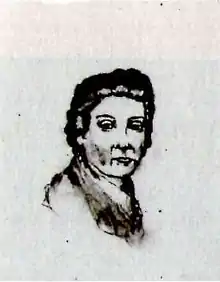Kamures Kadın
Kamures Kadın (Ottoman Turkish: کامرس قادین; 5 March 1855 – 30 April 1921; meaning "Bringer of pleasure"[1]) was the first wife and chief consort of Sultan Mehmed V of the Ottoman Empire.[2]
| Kamures Kadın | |||||
|---|---|---|---|---|---|
 | |||||
| Born | 5 March 1855 Ubykhia, Circassia | ||||
| Died | 30 April 1921 (aged 66) Şehzade Mahmud Necmeddin Palace, Kuruçeşme, Constantinople, Ottoman Empire (present day Istanbul, Turkey) | ||||
| Burial | Mehmed V Mausoleum, Eyüp, Istanbul | ||||
| Spouse | |||||
| Issue | Şehzade Mehmed Ziyaeddin | ||||
| |||||
| Religion | Sunni Islam | ||||
Early life
Of Circassian origin, Kamures Kadın was born on 5 March 1855[3] in Ubykhia, Circassia. She belonged to the Ubykh sub-ethnic group of Circassians.[4]
Marriage
Kamures married Mehmed on 30 September 1872 in the Ortaköy Palace.[4] A year after the marriage, on 26 August 1873, she gave birth to her only son, Şehzade Mehmed Ziyaeddin.[5] On 27 April 1909, after Mehmed's accession to the throne,[6] she was given the title of "Senior Consort".[2]
Safiye Ünüvar, a teacher at the Palace School, commented in her memoirs about her beauty, and said that she still some of her looks, when the two met in 1915.[7][8] Kamures had occupied herself with reading history, and whenever Safiye visited her she would always bring up with the subject of Ottoman history.[9]
In 1918, she met with the Tsar Boris III of Bulgaria, when he visited Istanbul.[4][10] On 30 May 1918, Kamures met with the Empress Zita of Bourbon-Parma in the harem of Yıldız Palace, when the latter visited Istanbul with her husband Emperor Charles I of Austria.[11]
Philanthropy
In 1912, the "Hilal-i Ahmer Centre for Women" was organised within the "Ottoman Hilal-i Ahmer Association", a foundation established in 1877 to provide medical care in Istanbul and surrounding communities.[12] Kamures served as the honourary president of this organization.[13] The same year, she also received the Ottoman Red Crescent Medal (Osmanlı Hilal-i Ahmer Madalyası), which was created shortly after the start of the Balkan Wars in November 1912. The award was given to those who would render beneficent services, materially or morally, to the organisation. She was the only Ottoman Muslim woman before the First World War to have received the medal in gold.[14]
In February 1914, the organisation announced the start of a course for nursing aids, which would consist of eighteen lessons of two hours each on Fridays and Sundays. The classes were to be taught by Besim Ömer and Akıl Muhtar. Between 40 and 50 women participated in the course and at the end of the five months course 27 women successfully took the exam. These 27 women, who were all wives and daughters of prominent Ottoman officials, received their certificate during a ceremony in the presence of Kamures, of Naciye Sultan and her mother and other palace women.[15]
Death
After Mehmed's death on 3 July 1918,[16] she settled in the palace of Şehzade Mahmud Necmeddin in Kuruçeşme, where she died on 30 April 1921, at the age of sixty six. She was buried in the mausoleum of her husband located in the Eyüp Cemetery, Istanbul.[13][7][8]
Honour
- Ottoman Red Crescent Medal in Gold, 1912[14]
Issue
| Name | Birth | Death | Notes |
|---|---|---|---|
| Şehzade Mehmed Ziyaeddin | 26 August 1873[5][2] | 30 January 1938[5] | married five times, and had issue, two sons and six daughters |
References
- Brookes 2010, p. 207 n. 7.
- Uluçay 2011, p. 260.
- Brookes 2010, p. 283.
- Açba 2007, p. 163.
- Brookes 2010, p. 291.
- Faroqhi, Suraiya (2008). The Cambridge History of Turkey. Cambridge University Press. p. 79. ISBN 978-0-521-62096-3.
- Brookes 2010, p. 207.
- Sakaoğlu 2008, p. 701.
- Brookes 2010, p. 231.
- Sakaoğlu 2008, p. 700.
- Açba, Leyla (2004). Bir Çerkes prensesinin harem hatıraları. L & M. p. 56. ISBN 978-9-756-49131-7.
- Hacker, Barton; Vining, Margaret (17 August 2012). A Companion to Women's Military History. BRILL. p. 199. ISBN 978-9-004-21217-6.
- Açba 2007, p. 164.
- Os, Nicolina Anna Norberta Maria van (31 October 2013). Feminism, Philanthropy and Patriotism: Female Associational Life in the Ottoman Empire. Leiden University Institute for Area Studies (LIAS), Faculty of Humanities, Leiden University. pp. 449–50.
- Os, Nicolina Anna Norberta Maria van (31 October 2013). Feminism, Philanthropy and Patriotism: Female Associational Life in the Ottoman Empire. Leiden University Institute for Area Studies (LIAS), Faculty of Humanities, Leiden University. pp. 451–52.
- Tucker, Spencer C. (October 28, 2014). World War I: The Definitive Encyclopedia and Document Collection [5 volumes]: The Definitive Encyclopedia and Document Collection. ABC-CLIO. p. 1071. ISBN 978-1-851-09965-8.
Sources
- Açba, Harun (2007). Kadın efendiler: 1839-1924. Profil. ISBN 978-9-759-96109-1.
- Brookes, Douglas Scott (2010). The Concubine, the Princess, and the Teacher: Voices from the Ottoman Harem. University of Texas Press. ISBN 978-0-292-78335-5.
- Sakaoğlu, Necdet (2008). Bu mülkün kadın sultanları: Vâlide sultanlar, hâtunlar, hasekiler, kadınefendiler, sultanefendiler. Oğlak Yayıncılık. ISBN 978-9-753-29623-6.
- Uluçay, Mustafa Çağatay (2011). Padişahların kadınları ve kızları. Ankara: Ötüken. ISBN 978-9-754-37840-5.
.svg.png.webp)
